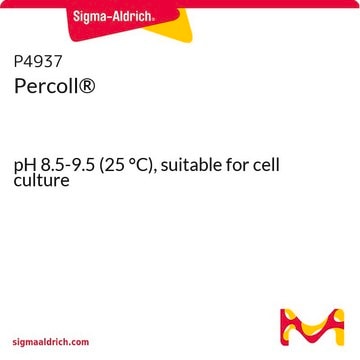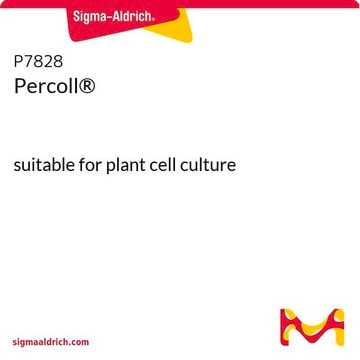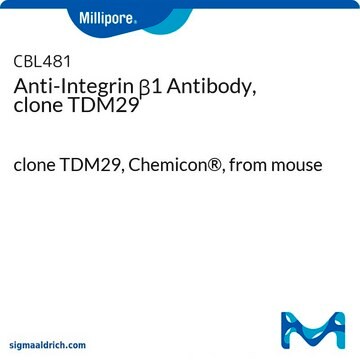Percoll is produced by Cytiva, formerly known as GE Life Sciences. Details regarding the proprietary manufacturing process are not publicly available. However, it can be mentioned that the Percoll particles range in size from 15 to 30 nanometers. While the density of Percoll solution is measured, the specific information regarding the amount of coating on the silica particles is not provided.
P1644
Percoll®
pH 8.5-9.5 (20 °C)
Synonym(s):
Percoll Density Gradient Media
About This Item
Recommended Products
sterility
aseptically filled
Quality Level
color
clear colorless to faint yellow
pH
8.5-9.5 (20 °C)
application(s)
hematology
histology
storage temp.
2-8°C
Looking for similar products? Visit Product Comparison Guide
General description
Application
Legal Information
related product
Storage Class Code
10 - Combustible liquids
WGK
WGK 3
Flash Point(F)
Not applicable
Flash Point(C)
Not applicable
Personal Protective Equipment
Choose from one of the most recent versions:
Certificates of Analysis (COA)
Don't see the Right Version?
If you require a particular version, you can look up a specific certificate by the Lot or Batch number.
Already Own This Product?
Find documentation for the products that you have recently purchased in the Document Library.
Customers Also Viewed
Articles
Centrifugation enables the separation of particles by sedimentation. Learn how to separate particles using a centrifuge and how to use Stokes' law to calculate the velocity of sedimentation.
Centrifugation enables the separation of particles by sedimentation. Learn how to separate particles using a centrifuge and how to use Stokes' law to calculate the velocity of sedimentation.
Centrifugation enables the separation of particles by sedimentation. Learn how to separate particles using a centrifuge and how to use Stokes' law to calculate the velocity of sedimentation.
Centrifugation enables the separation of particles by sedimentation. Learn how to separate particles using a centrifuge and how to use Stokes' law to calculate the velocity of sedimentation.
Protocols
To prepare a Percoll gradient, the osmolality of Percoll must be adjusted with saline or cell culture medium to make Percoll isotonic with physiological salt solutions.
To prepare a Percoll gradient, the osmolality of Percoll must be adjusted with saline or cell culture medium to make Percoll isotonic with physiological salt solutions.
To prepare a Percoll gradient, the osmolality of Percoll must be adjusted with saline or cell culture medium to make Percoll isotonic with physiological salt solutions.
To prepare a Percoll gradient, the osmolality of Percoll must be adjusted with saline or cell culture medium to make Percoll isotonic with physiological salt solutions.
-
What is the details about the manufacturing process of Percoll, specifically regarding the amount of PVP used during bead soaking or the approximate PVP concentration within Percoll?
1 answer-
Helpful?
-
-
What is procedure for sperm preparation for ivf with percoll gradient
1 answer-
Please note that this product is intended for research use only. This material is not tested for the isolation of sperm samples. The following reference may be helpful:
Chen. Y. et al., Int. J. Fertil., 37, 315-319 (1992).Please see the link below to review the product datasheet for additional information.
https://www.sigmaaldrich.com/deepweb/assets/sigmaaldrich/product/documents/977/430/p1644pis.pdfHelpful?
-
-
CAN I FREEZE PERCOLL (P1644)? I SEE IN OTHER REF THAT I CAN, BUT NOT IN THIS REF
1 answer-
This material should not be stored frozen for long periods of time. As per the product information sheet, if stored at –20 °C, gradients form upon thawing, necessitating mixing the contents of the bottle before use. Please see the link below to review the product datasheet for further information:
https://www.sigmaaldrich.com/deepweb/assets/sigmaaldrich/product/documents/426/291/percoll-product-info-sheet-ms.pdfHelpful?
-
-
Percoll (P1644) 을 gradient 만드는데 사용했는데요, P4937도 같은 용도로 사용 가능한가요?
1 answer-
Yes, product P4937 can be used for the same use as product P1644.
Helpful?
-
-
I often find crystals. Can I filter the solution before use? What filter size could I use without affecting the functionality of the product?
1 answer-
Particles may be removed by filtration or low speed centrifugation. More information about the particles filtration can be found in the product data sheet:
https://www.sigmaaldrich.com/deepweb/assets/sigmaaldrich/product/documents/977/430/p1644pis.pdf
https://www.sigmaaldrich.com/deepweb/assets/sigmaaldrich/product/documents/426/291/percoll-product-info-sheet-ms.pdfHelpful?
-
-
Can Percoll®, Product P1644, be autoclaved?
1 answer-
Percoll can be autoclaved, but this must be done without any salts or sucrose present.
Helpful?
-
-
What is the difference between Percoll® Products P4937 and P1644?
1 answer-
Product Nos. P1644 and P4937 are both Percoll. Product No. P4937 has additional testing for use in cell culture.
Helpful?
-
-
What is the Department of Transportation shipping information for this product?
1 answer-
Transportation information can be found in Section 14 of the product's (M)SDS.To access the shipping information for this material, use the link on the product detail page for the product.
Helpful?
-
-
When using Product P1644, Percoll®, what density should I use for my particular system?
1 answer-
The product information sheet (under Documents, above) has a table of densities for different organelles and cell types.
Helpful?
-
-
Can you help me calculate gradients for Percoll®, Product P1644?
1 answer-
The product information sheet (under Documents, above) has an equation for calculating density of a given solution.
Helpful?
-
Active Filters
Our team of scientists has experience in all areas of research including Life Science, Material Science, Chemical Synthesis, Chromatography, Analytical and many others.
Contact Technical Service










